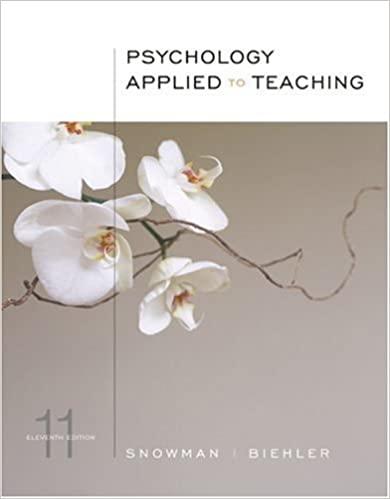Question
Watch the video clip of a mother and child who have completed Mary Ainsworth's Strange Situation. Based on what you observe, describe the attachment style
Watch the video clip of a mother and child who have completed Mary Ainsworth's Strange Situation. Based on what you observe, describe the attachment style of this child. Your assessment should include four specific parts:
- A very brief review (about a paragraph only) of the four attachment styles (secure, insecure-avoidant, insecure-resistant/ambivalent, and insecure-disorganized/disoriented);
- A brief review (about two to three paragraphs) of what behaviors, generally speaking, do we see from secure AND insecure (all types of insecure) children in all types of situations, not just the Ainsworth Strange Situation. For example, what do secure children generally do when they are separated from their mother? or, What do insecure children generally do when they encounter strangers?
- Based on the behavior of the girl and hermother, categorize herattachment style? Which of her behaviors and/or hermother's led you to this conclusion? Be as specific as possible.
- Assuming that secure attachment is optimal, what recommendations, if any, would be offered to this mother to help her optimize the attachment with her young daughter
Video:
Ainsworth Strange Situation Transcript
NARRATOR: But can the essential elements of home life be translated into a standard laboratory setting for controlled scientific study?
LISBETH: We're going to get you [INAUDIBLE]. NARRATOR: After conducting extensive observations of parents and children at home, a student of Bowlby's, Mary Ainsworth devised such a procedure called the strange situation, which places the child under some stress. It has become the most widely used, standardized way to assess the quality of a child's attachment to their caregiver. LISBETH: So-- NARRATOR: Here, the researchers are recording how 14-month-old Lisa responds in this attractive, but unfamiliar, setting. How will she react to a stranger? What will happen when her mother leaves the room, and when she returns? LISBETH: [INAUDIBLE]. NARRATOR: It's Lisa's behavior when her mother returns-- what psychologists call, the reunion-- that they are particularly interested in. RESEARCHER: Most importantly, is to look for the type of imbalance that a child strikes between an attachment made, and on the other hand, to explore the play material. LISBETH: Hello. NARRATOR: Once Lisa has settled down to play, a stranger enters the room and sits in the chair reading a magazine. LISBETH: Did you watch the ball? Where's the ball? NARRATOR: After a couple of minutes, the stranger attempts to interact with Lisa. STRANGER: [INAUDIBLE]. Come on back. NARRATOR: Soon after, Lisbeth gets a cue to leave the room. STRANGER: [Tries to interact with the child.] [LISA CRYING] NARRATOR: The stranger tries to comfort Lisa, but in vain. Lisbeth comes back into the room and the camera records how Lisa reacts. LISBETH: You [INAUDIBLE]. NARRATOR: Now, the first part of the procedure is over, and Lisbeth settles Lisa down again. The stranger leaves them alone together. LISBETH: Come on, [INAUDIBLE]. NARRATOR: And soon after, Lisbeth goes too. [LISA CRYING] Lisa is on her own. Her distress is plain to see. Once again, the efforts of the stranger to conceal Lisa are to no avail. LISBETH, reentering the room: Lisa, hey, there. Hey [INAUDIBLE]. NARRATOR: But Lisbeth manages to calm her almost at once. And shortly afterwards, the observation ends. LISBETH: [INAUDIBLE]. NARRATOR: Lisa showed outward signs of what's called secure attachment.
Step by Step Solution
There are 3 Steps involved in it
Step: 1

Get Instant Access to Expert-Tailored Solutions
See step-by-step solutions with expert insights and AI powered tools for academic success
Step: 2

Step: 3

Ace Your Homework with AI
Get the answers you need in no time with our AI-driven, step-by-step assistance
Get Started


